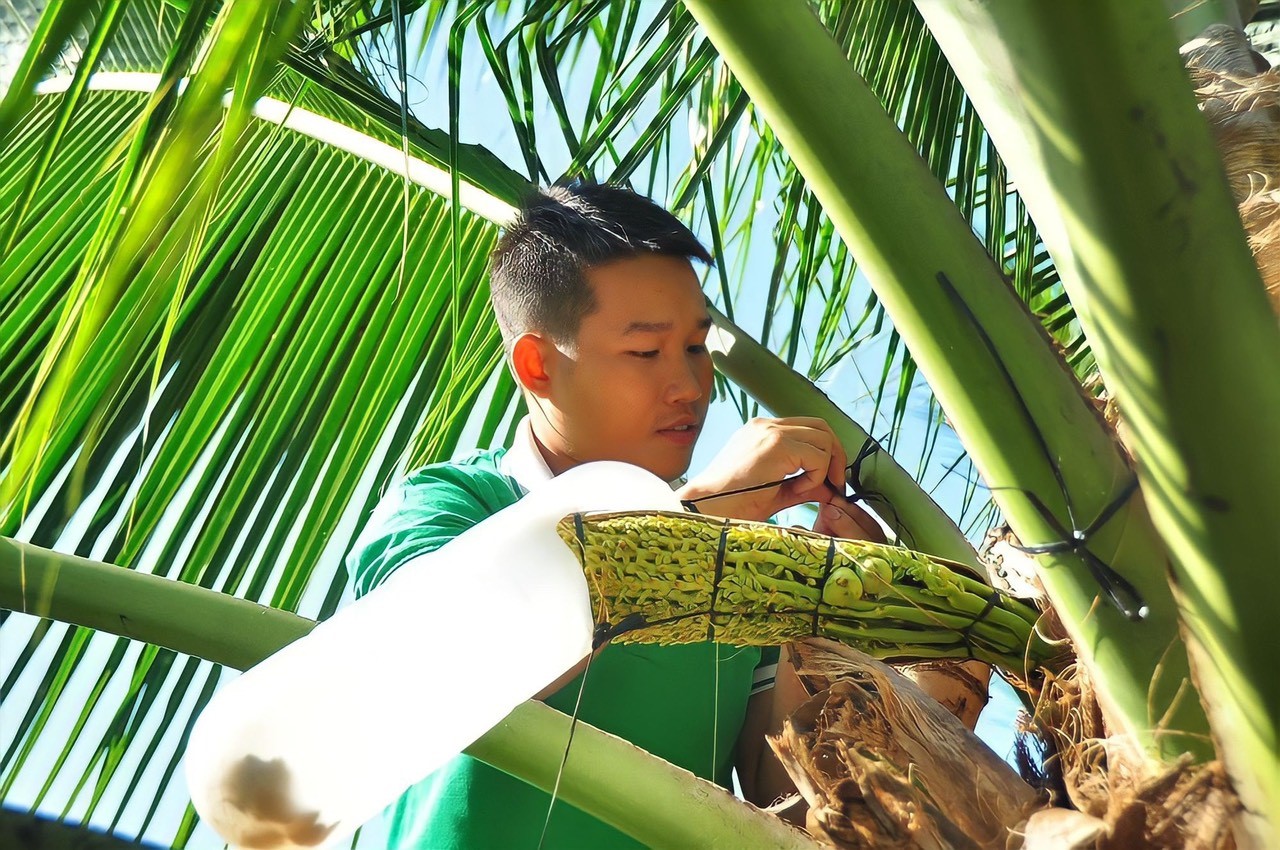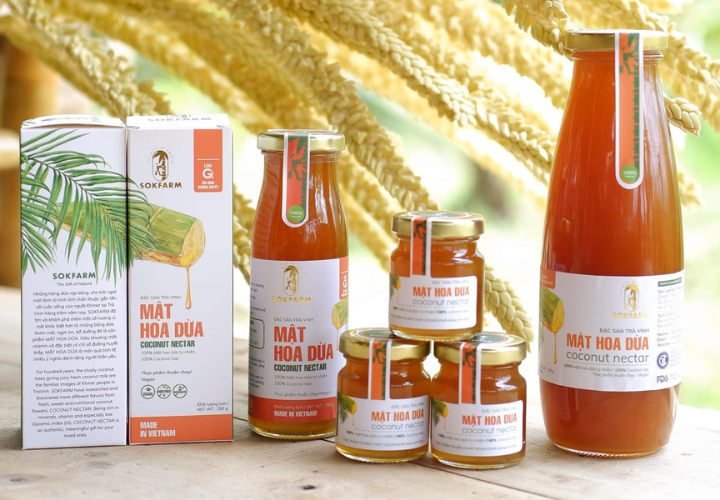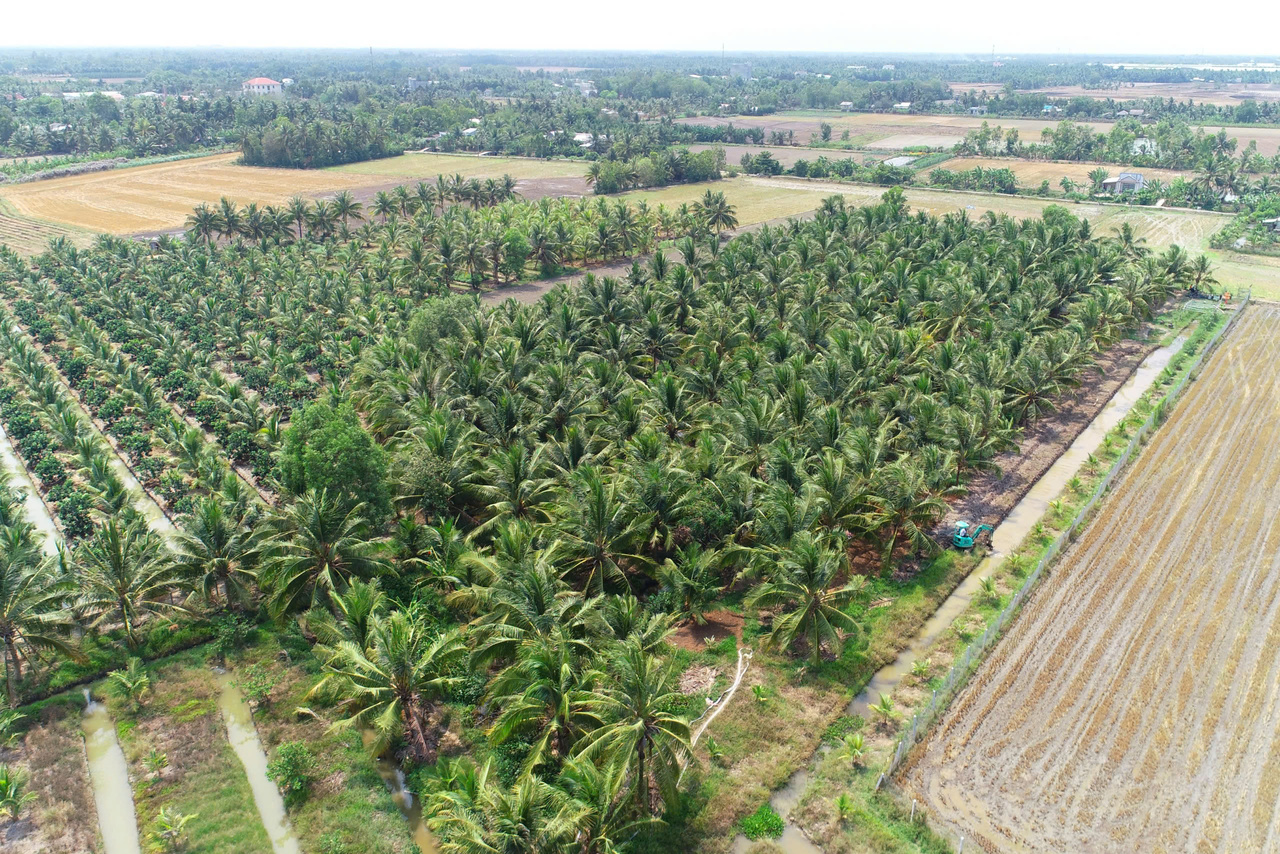In May, over 7 tons of organic coconut sugar, a 5-star OCOP (One Commune One Product) product from Vinh Long, were officially exported to the US. This milestone marks a Mekong Delta startup reaching the high-end market with nectar from native coconut blossoms.
The brand behind this transformation is Sokfarm, a 6-year-old company based in Tieu Can, Vinh Long, specializing in coconut nectar products. Starting with just a few coconut trees, Sokfarm now works with over 25 hectares of raw materials, collaborating with 48 households. The yield reaches 70 tons of fresh nectar per hectare annually, equivalent to 40-60 million VND per month. The total annual output of fresh coconut nectar harvested and processed is about 700-900 tons.
Their product catalog focuses on six main lines: fresh coconut nectar, organic concentrated coconut nectar, organic coconut sugar, coconut nectar vinegar, organic coconut nectar soy sauce, and fermented coconut nectar products.
Finding a path for the Mekong Delta's iconic tree
Looking at the exported shipment, Thach Thi Chal Thi (Kaity) recalls her entrepreneurial journey. In 2018, coconut prices in the Mekong Delta hit rock bottom. 12 coconuts sold for only 25,000 VND, and one hectare of coconut trees yielded less than 2 million VND per month. Another characteristic of coconut trees is that they require 6-7 years of care before the first harvest. “If we don’t add value, coconuts could become a symbol of poverty," Kaity thought.
Instead of finding new markets for coconuts, Kaity was captivated by the idea of harvesting nectar from coconut blossoms, a model already successful in Thailand, Indonesia, and the Philippines. Kaity and her husband, Pham Dinh Ngai (now CEO of Sokfarm), decided to explore this method, applying it directly to coconut farms in Vinh Long.
They learned how to massage coconut blossoms, cut them at the right time, and collect the nectar, similar to how the Khmer people harvest palm sugar. Coconut nectar is a purely plant-based product extracted from coconut blossoms (not honey from bees). Daily, farmers must climb coconut trees (4 to 15 years old) twice to massage the blossoms, cut a fresh surface, and collect the nectar (similar to palm sugar harvesting). The fresh coconut nectar is then brought to the factory for processing. Eight liters of fresh nectar produce one liter of concentrated nectar.
 |
The first eight months were a series of failures: incorrect techniques, blossoms not secreting nectar, coconut trees withering, and spoiled nectar. “There were times when I stood silently in the garden, wanting to give up. But my stubborn love for my homeland kept me going," Kaity said. She and her husband analyzed each step, realizing that the specific trees and soil had unique requirements. From there, she meticulously adjusted each step and technique. After many sleepless nights, the first drops of nectar began to flow, marking the beginning of the Sokfarm ecosystem.
Despite having a standardized production process, challenges persisted. When Kaity proposed harvesting nectar instead of coconuts, she didn't receive support from coconut farmers. Many shook their heads, believing her method was too new and risky. It took months of persuasion, analysis, and inviting them to experience the process firsthand before she could gradually change their mindset. One household with only 9 coconut trees, after applying the new model, earned 2.5 million VND per month, equivalent to the income from a 250-tree coconut farm if only selling coconuts, representing a nearly 30-fold increase in income.
In 2019, Kaity and her husband established Tra Vinh Farm Co., Ltd., using the brand name Sokfarm, meaning "happiness" in Khmer. This marked the transition from an individual model to a business, shaping a long-term vision.
Sokfarm chose a 100% natural approach. The nectar is collected manually using Khmer techniques and processed in an ISO 22000 and FDA-certified factory without chemical preservatives. The product retains its nutrients, aligning with the global trend of sustainable consumption.
As the first shipments were well-received by the market, she expanded the raw material area to two hectares, creating jobs for 10 local workers and collaborating with three coconut farming households. In 2020, they further expanded to four hectares, employing 20 local workers and partnering with more coconut farming households.
Today, the company has around 56 employees, mostly local workers, including over 70% Khmer people and 80% women.
 |
From livelihoods for farmers to Net Zero goals
With a long-term vision, Sokfarm doesn't stop at production but actively builds the entire value chain: from market research, raw material development, processing research, communication, to distribution. "SMEs can't do everything, but they can do things no one else has done, like with coconut blossoms, to create a unique advantage," said Pham Dinh Ngai, the company's CEO.
The company now has over 30 coconut nectar products: sugar, vinegar, beverages, nutritional foods, and more. Each product line is continuously tested and improved to suit domestic and export consumer preferences.
With over 40 agents in 20 provinces, Sokfarm distributes 3,000 products monthly, generating over 200 million VND in revenue. The company owns over 25 hectares of raw materials, collaborating with 48 farming households, with a yield of over 70 tons of fresh coconut nectar per hectare. International certifications like HACCP, FDA, ISO 22000, and 3-star OCOP serve as stepping stones for the company to reach the global market.
According to the CEO, as climate change intensifies, coconut trees are a drought- and salt-tolerant crop in the Mekong Delta. The company aims to partner with 500 farming households by 2030 and 1,000 by 2035.
Sokfarm's vision isn't just about revenue and profit, but about building a sustainable agricultural community centered around local agricultural products, driven by science, technology, and innovation. Ngai said he and his wife are also researching and implementing processes to sell carbon credits from coconut trees.
 |
Studies show that for each coconut tree over 10 years old, the carbon credits can be calculated at the same rate as reforestation, approximately 1 USD per tree. Currently, the farm has 25,000 coconut trees over 10 years old, potentially generating at least 25,000 USD for farmers, not to mention the additional trees planted each year. "This is money that farmers never thought they could earn from simply growing trees," he shared.
As Vietnam commits to achieving Net Zero greenhouse gas emissions by 2050, the economic value of coconut trees will continue to increase through carbon credit sales. One hectare of coconut trees can absorb 70-75 tons of CO2 annually. From a small idea in a hometown coconut garden, Sokfarm is expected to become a pioneering enterprise, helping to redefine the value of Vietnamese agriculture.
Thai Anh
If you have a similar story about your business or know of an organization striving for innovation, please share it with us via the link here. Suitable contributions will be selected for publication on the special page, helping to inspire and spread the spirit of "rising" to the Vietnamese business community. |












